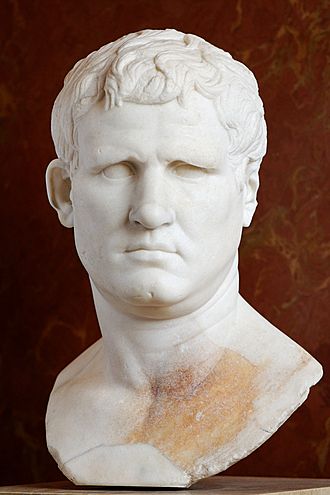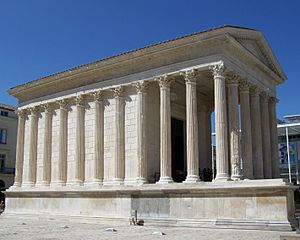Marcus Vipsanius Agrippa facts for kids
Quick facts for kids
Marcus Vipsanius Agrippa
|
|
|---|---|

|
|
| Born | c. 63 BC |
| Died | 12 BC (aged 50–51) |
| Resting place | Mausoleum of Augustus |
| Nationality | Roman |
| Occupation | Military commander and politician |
|
Notable work
|
Pantheon (original) |
| Office | Consul (37, 28–27 BC) |
| Spouse(s) | Caecilia Attica Claudia Marcella Maior Julia the Elder |
| Children |
List
Vipsania Agrippina Vipsania Attica (disputed) Vipsania Marcella Vipsania Marcellina (disputed) Gaius Caesar Julia the Younger Lucius Caesar Agrippina the Elder Agrippa Postumus |
| Family | gens Vipsania |
| Military service | |
| Allegiance | Augustus |
| Years of service | 45–12 BC |
| Battles/wars | Battle of Munda (45 BC) Battle of Mutina (43 BC) Battle of Philippi (42 BC) Battle of Mylae (36 BC) Battle of Naulochus (36 BC) Battle of Actium (31 BC) |
Marcus Vipsanius Agrippa (/əˈɡrɪpə/; around 63 BC – 12 BC) was a famous Roman general, politician, and architect. He was a very close friend and helper to the first Roman emperor, Augustus. Agrippa built many important structures, like the original Pantheon in Rome. He was also known for his big military wins, especially the Battle of Actium in 31 BC, where he defeated Mark Antony and Cleopatra.
Contents
Early Life and Family
Agrippa was born around 63 BC. We don't know exactly where. His family was not famous in Roman public life and came from the countryside. His father was named Lucius Vipsanius. Agrippa also had an older brother, also named Lucius Vipsanius, and a sister, Vipsania Polla.
Agrippa's Career and Achievements
Agrippa met the future emperor Augustus, who was then known as Octavian, in a place called Apollonia. After Julius Caesar was killed in 44 BC, Octavian returned to Italy. Around this time, Agrippa became a tribune of the plebs, a public official.
Military Commander
Agrippa served as a military commander. He fought alongside Octavian and Caesar's former general, Mark Antony, in the Battle of Philippi. In 40 BC, he played a big part in the Perusine War against Mark Antony's brother and wife.
In 39 or 38 BC, Agrippa became governor of Transalpine Gaul. He stopped a rebellion by the Aquitanians and fought against Germanic tribes. In 37 BC, he became a consul, which was a very important position. He was much younger than the usual age for this role. He helped prepare for a war against Sextus Pompey, who was stopping grain shipments to Rome.
Agrippa defeated Pompey in the battles of Mylae and Naulochus in 36 BC. Later, in 31 BC, Agrippa led Octavian's fleet to victory at the famous Battle of Actium. This win helped Octavian become the first Roman emperor, Augustus.
Helping Augustus Build Rome
After the victory at Actium, Agrippa remained a close friend and helper to Augustus. Agrippa helped Augustus make Rome "a city of marble." He fixed and improved aqueducts to bring fresh water to all Roman citizens. He also built many public baths, porticoes (covered walkways), and gardens for everyone to enjoy.
Agrippa was given powers almost as great as Augustus himself. He could stop laws passed by the Senate and suggest new laws for the people to approve.
Writer and Geographer
Agrippa was also known as a writer, especially about geography. He helped complete a full survey of the Roman Empire, which Julius Caesar had planned. Using this information, Agrippa created a circular map. Augustus later had this map carved into marble and placed in a public building. Agrippa also wrote an autobiography, but it is now lost.
Death and Legacy
Agrippa's last public service was starting the conquest of the upper Danube River region in 13 BC. This area later became the Roman province of Pannonia. He died in Campania in 12 BC, when he was about 50 or 51 years old. His son, born after his death, was named Marcus Vipsanius Agrippa Postumus in his honor.
Augustus honored Agrippa with a grand funeral and mourned him for over a month. Augustus also personally made sure all of Agrippa's children received a good education. Even though Agrippa had built his own tomb, Augustus had Agrippa's remains placed in his own mausoleum.
Agrippa's Lasting Impact
Agrippa was Augustus's most skilled military commander and his closest friend. He served Augustus loyally for more than 30 years.
Agrippa set a standard for the Roman foot in 29 BC. This also defined a "pace" as 5 feet. A Roman mile was 5,000 Roman feet. The term Via Agrippa refers to the network of roads Agrippa built in Gaul (modern France). Some of these roads still exist today as paths or even highways.
The Roman tribe Agrippia was named in his honor.
Marriages and Children
Agrippa married three times:
- Cecilia Pomponia Attica. They had one or two daughters:
- Vipsania Agrippina
- Vipsania Attica (some historians disagree about this daughter)
- Claudia Marcella Maior. They had one or two daughters:
- Vipsania Marcella
- Vipsania Marcellina (some historians disagree about this daughter)
- Giulia Maior. They had three sons and two daughters:
- Gaius Caesar
- Vipsania Julia Minor
- Lucius Caesar
- Vipsania Agrippina Maior
- Agrippa Postumus
Through his many children, Agrippa became an ancestor to many important members of the Julio-Claudian dynasty. This family ruled Rome for many years, and Agrippa helped them gain their power.
Images for kids
-
Bust of Agrippa, Pushkin Museum
-
The theatre at Merida, Spain; Agrippa helped build it between 16 and 15 BC.
-
An Audience at Agrippa's, a painting by Lawrence Alma-Tadema
See also
 In Spanish: Marco Vipsanio Agripa para niños
In Spanish: Marco Vipsanio Agripa para niños





